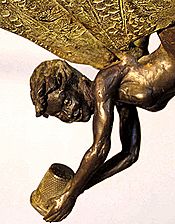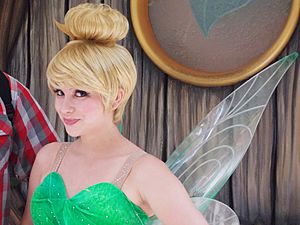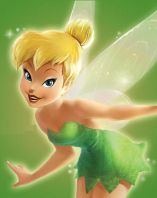Tinker Bell facts for kids
Quick facts for kids Tinker Bell |
|
|---|---|
| Peter Pan character | |

Tinker Bell (2005, bronze) by Diarmuid Byron O'Connor
|
|
| First appearance | Peter Pan (1904) |
| Created by | J. M. Barrie |
| Information | |
| Nickname(s) | Tink |
| Species | Fairy |
| Gender | Female |
| Occupation | Tinker fairy |
Tinker Bell is a famous fictional character created by J. M. Barrie. She first appeared in his 1904 play Peter Pan and later in the 1911 novelization Peter and Wendy. Tinker Bell has been in many movies and TV shows based on the Peter Pan stories. One of her most well-known appearances is in the 1953 animated Walt Disney movie Peter Pan.
She also appears in the official sequel book Peter Pan in Scarlet by Geraldine McCaughrean. This book was asked for by Great Ormond Street Hospital. Tinker Bell is also in the "Peter and the Starcatchers" book series by Ridley Pearson and Dave Barry.
At first, Barrie described her as just "a common fairy". But her animated version became very popular. She is now a widely recognized symbol of The Walt Disney Company. She is also the main character of the Disney Fairies media franchise. This includes a series of movies released directly to DVD, like Tinker Bell. She also appeared in Walt Disney's Wonderful World of Color.
Contents
Tinker Bell in Original Stories
Barrie wrote that Tinker Bell was a fairy who fixed pots and kettles. She was like a tinker among the fairy folk. She speaks with sounds like a tinkling bell. Only those who know the language of fairies can understand her.
Tinker Bell can sometimes be a bit grumpy, spoiled, or jealous. But she is also very helpful and kind to Peter. Her personality can go to extremes because fairies are so small. They can only feel one strong emotion at a time. So, if she is angry, she cannot feel compassion at the same time. Fairies can help others fly by sprinkling them with fairy dust. In the Disney movies, this is called "pixie dust." In the Dave Barry and Ridley Pearson books, it's called "starstuff."
At the end of Barrie's novel, Peter flies back to find an older Wendy. It is mentioned that Tinker Bell died the year after Wendy and her brothers left Neverland. Peter no longer remembers her.
Tinker Bell on Stage
In the first stage plays, Tinker Bell was shown as a moving light. This light was made by a small mirror reflecting light from a strong lamp. Her voice was made using a collar of bells and two special bells Barrie brought from Switzerland.
The show's programs listed a 'Jane (or Jenny) Wren' as playing Tinker Bell. This was a joke to add to the fairy's mystery. It even tricked the tax office, who sent Jane Wren a tax bill!
In the musical version of the play, Tinker Bell was also a darting light. Her sound was made by a celesta, a musical instrument.
Tinker Bell in Movies
Movies were the first to give Tinker Bell sounds or speech. Sometimes it was musical sounds, or the sound of a bell. Other times, she had human speech.
Early Film Appearances
In the 1924 silent film, Tinker Bell was played by actress Virginia Browne Faire.
Disney's Tinker Bell
In Walt Disney's 1953 animated movie, Tinker Bell is blonde and wears green clothes. She does not speak. Like in the original play, Peter tells the audience what she is saying. Bell sounds are used when she makes gestures.
Tinker Bell has become one of Disney's most important symbols for over 50 years. She is often called "a symbol of 'the magic of Disney'". She has appeared in TV commercials and show openings. She sprinkles pixie dust with a wand to make other Disney characters feel magical. However, the 1953 animated Tinker Bell never actually used a wand. In Disney's official records, she is called a pixie.
Some people believe the original animated Tinker Bell was based on Marilyn Monroe. But Disney animator Marc Davis actually used actress Margaret Kerry as his model. He drew Tinker Bell as a young, pretty, blonde, blue-eyed girl. She has an exaggerated hourglass figure. She wears a short, bright green dress with a stiff edge and green slippers with white puffs. She leaves small amounts of pixie dust behind her when she moves. This dust can help humans fly if they think happy thoughts.
Since 1954, Tinker Bell has hosted many of Disney's live-action TV shows. She also appears in Disney movie ads, flying over Disneyland with her magic wand and fairy dust. This started with Disneyland, which introduced the theme park to the public. She then appeared in Walt Disney Presents, Walt Disney's Wonderful World of Color, and The Wonderful World of Disney.
In 1988, she was in the final scene of Disney's Who Framed Roger Rabbit. She sprinkled fairy dust on the screen after Porky Pig's farewell. Tinker Bell also appeared with other Disney characters, like Chip 'n Dale, in many Disney comics. In these comics, she could speak. Tinker Bell also helps characters in the Kingdom Hearts video game series. She also appeared as a card in the 1993 video game Mickey's Memory Challenge.

At Disneyland, Tinker Bell is a big part of Peter Pan's Flight. This is a ride based on the animated film. Starting in 1961, she also performed live. She flew through the sky on a wire from the top of the Matterhorn Bobsled Ride. This happened at the start of the nightly fireworks shows. The first person to play her was 71-year-old former circus performer Tiny Kline.
In 2008, Disney announced that a Tinker Bell float would be added to the Disney's Electrical Parade. This parade is at Disney California Adventure Park at the Disneyland Resort. It was the first new float added in decades.
Disney Fairies Series
Tinker Bell became the main character of the new Disney Fairies series, which started in 2005. Besides many toys and products, the 2008 movie Tinker Bell was the first of five movies released directly to DVD. These movies are set in Pixie Hollow. In the Fairies universe, Tinker Bell can speak. Her voice is done by Mae Whitman in these animated movies.
At Disneyland, a "Pixie Hollow" area opened in 2008. Guests can meet Tinker Bell and her fairy friends there. A similar area called "Tinker Bell's Magical Nook" is in Adventureland at Walt Disney World's Magic Kingdom in Florida.
In 2009, Tinker Bell became the smallest wax figure ever made at Madame Tussauds. She was only five and a half inches tall.
On September 21, 2010, Tinker Bell received the 2,418th star on the Hollywood Walk of Fame. She was the thirteenth fictional character and the fifth Disney character to get this honor. Tinker Bell's star celebrated the Hollywood Walk of Fame's 50th anniversary.
Since the 2012 movie Secret of the Wings, Tinker Bell is the first Disney fairy to have a sibling. She has a twin sister named Periwinkle, who is a frost fairy from the Winter Woods.
Tinker Bell in Hook (1991)
In the 1991 movie Hook, Tinker Bell is played by Julia Roberts. Peter is now an adult and has forgotten about Neverland. Tinker Bell takes him there to rescue his children. She convinces Captain Hook to give her three days to help Peter remember his past. This includes his ability to fly, fight, and crow. This ensures a fair fight between Peter and Hook.
After Peter remembers everything, Tinker Bell uses her magic to become human-sized. She shares a kiss with Peter. When Peter returns to London, Tinker Bell appears to him one last time. She is seen on the Peter Pan statue in Kensington Gardens. She tells him she will always love him.
In this movie, Tinker Bell is a winged, six-inch-tall tomboyish fairy. She has short, red hair and wears a ragged leather tunic with matching shorts. She carries a small dagger. When she flies, she looks like a traditional ball of light. Tinker Bell is much stronger than her size suggests. She can lift and carry a grown man. She can also use a human sword while flying, making it look like the sword is floating. This movie is also the only one where Tinker Bell can turn into a human-sized version of herself. The movie Hook changes the original story by having Tinker Bell live into modern times. The original book says fairies live short lives and Tinker Bell died a year after the Darling children's adventures.
Tinker Bell in Peter Pan (2003)
In the 2003 movie Peter Pan, director P. J. Hogan first planned to use a computer-generated Tinker Bell. But he decided to use actress Ludivine Sagnier instead. They combined her acting with digital effects to capture her expressions.
Tinker Bell in Peter Pan in Scarlet
Tinker Bell returns in the official sequel book Peter Pan in Scarlet. When Wendy and the others reach Neverland, they ask Peter about her. He says he doesn't know anyone named Tinker Bell. This is because he no longer remembers her after she died.
Wendy and the Lost Boys tell Fireflyer, a silly blue fairy, about Tinker Bell. When Fireflyer reaches the top of Neverpeak, he wishes to meet her. When they open Captain Hook's treasure chest, Tinker Bell is inside! Fireflyer is very happy. At first, Tinker Bell doesn't like him. But she eventually sees that Fireflyer is not so bad. In the end, they get married and sell dreams to the Roamers. These are former Lost Boys who Peter had cast out. Tinker Bell and Fireflyer have many adventures together.
Tinker Bell in Peter and the Starcatchers
In Dave Barry and Ridley Pearson's Peter and the Starcatchers book series, Tinker Bell first appears at the end of the first novel. She was originally a green and yellow bird. She was put into a bag of starstuff, which turned her into a fairy. Molly's father, Lord Leonard Aster, made her Peter's guardian. She follows him on all his adventures.
She doesn't like being called a fairy. She would rather be called "birdwoman" because of how she became a fairy. She is very protective of Peter. She hates it when he pays attention to other girls. She can be very rude to others. Only Peter can understand her perfectly. Most of the time, he doesn't tell others what she says about them, because it's usually insults. She can also make a very bright light. She uses this light as an attack against other creatures, especially Lord Ombra, one of the main bad guys in the series.
|
See also
 In Spanish: Campanilla para niños
In Spanish: Campanilla para niños


